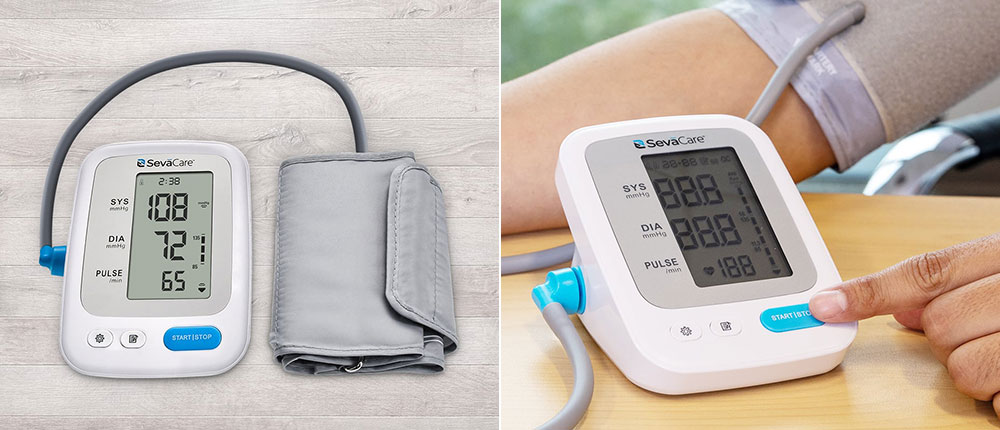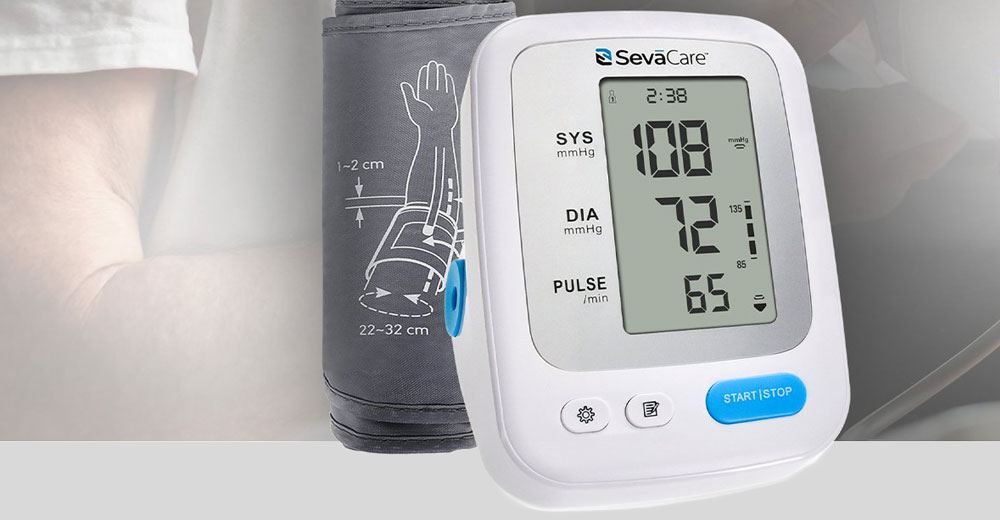The SevaCare Blood Pressure Arm Cuff Monitor by Monoprice provides more than what you might expect with a typical home health care product. Its price makes keeping regular tabs on your heart health affordable and efficient.
You might have a smartwatch that checks your blood pressure and pulse rate. Maybe you prefer a pocket-portable wrist blood pressure (BP) monitor instead of an upper arm cuff tethered to its display unit. But do those devices also alert you to potentially deadly notifications of irregular heartbeats and body movements?
For $27.99, you get a simple-to-use arm cuff monitor equipped with 360° intelligent automatic inflation technology that helps reduce measurement errors. The measurement unit starts and stops with the push of a single button.
This Monoprice device weighs 8.35 ounces and is suitable for use at home, in the office, or when traveling. It is convenient in any location as no stethoscope is required to take blood pressure readings manually. The arm cuff automatically inflates and deflates.
High-Quality Features
The lightweight monitor has a 3″ x 2″ LED display screen that shows up to 99 measurements for two users — so you can track up to 198 sessions.
Each record is logged with a time stamp. You can review the last three readings for historical data and observe changes in blood pressure and heart rate.

The device is World Health Organization (WHO)-certified for accuracy of blood pressure readings. It has sensors that alert you to body movements that might affect results. The health certification also assures accuracy from the irregular heartbeat (IHB) sensor.
To further assure accurate readings, the SevaCare Blood Pressure Monitor has over-pressure and low-power protection features that automatically power off the unit.
It includes an adjustable arm cuff with a strong Velcro, high-quality, dust-proof material. This design provides 360° support around the arm and adjusts to accommodate arms ranging from 8.7 to 12.6 inches.
More Than Personal Preference
I have used a variety of blood pressure monitors over the years. Being able to track blood pressure and heart rate is often a necessity when caring for older relatives and youngsters in addition to yourself.
High blood pressure doubles a person’s cardiovascular risk and is a significant risk factor leading to strokes, heart attacks, and other problems. It can result in blindness, kidney failure, and arterial blockages in the legs, according to medical warnings.
However, testing this SevaCare Blood Pressure Monitor made me question the general notion of product reliability. I regularly track my blood pressure, pulse rate, and other heart-healthy performances while engaging in a variety of everyday activities.
I often compare readings between my wrist-style BP monitor and my smartwatch’s health-tracking features. In the process, I noticed that measurement results varied in medical offices and emergency rooms where I was a patient. The BP and pulse numbers were significantly different depending on whether an arm cuff with a stethoscope was used or the cuff was tethered to a telemetry display.
No two types of devices produced the same results. However, numerous published medical accounts suggest that arm cuffs with the stethoscope method give more accurate BP results.
Those situations left me pondering two essential questions. Does it matter which type of blood pressure monitor I use? Is the SevaCare BP monitor a better choice?
Proper Fit Is Essential
When I first used SevaCare’s product, my blood pressure and heart rate readings were much higher than the results from my wrist BP monitor and smartwatch, which was the lowest of the three.
Repeated trials with the SevaCare monitor over three days showed lower BP and pulse numbers. But they were still higher than my own devices showed.
Testing during hours-long work sessions at my computer versus getting readings while occupied with more restful activities made a difference in results. My systolic reading (the pressure of blood pumping through arteries when the heart beats) was closer to that of the wrist cuff device. The same result followed for my diastolic reading (the blood pressure in the arteries of the “resting” heart between beats).
By the end of the third day of comparing BP and pulse readings from the three devices, I had very pleasing results with the SevaCare product. While all three device results were well within the cardiac safe range, SevaCare’s BP monitor was four numbers lower than my wrist monitor for both systolic and diastolic readings. Pulse rates differed by one number, with SevaCare being the top number.
Sizing Up the Differences
The American Heart Association publishes guidelines for blood pressure monitoring. Other documentation describes the ideal sizing requirements for monitoring devices. The Heart Association recommends upper arm monitors over other types of devices.
Not all cuff dimensions are the same or suitable. For instance, measurement errors can occur if a cuff is too small or too large. Inaccuracies in automated devices not tested for accuracy are more common with errors in systolic BP.
In general, recommendations suggest picking a cuff that covers two-thirds of the distance between the elbow and shoulder. Cuff sizing typically comes in at least three options — large adult, regular adult, and pediatric.
Bottom Line
The SevaCare monitor I used is labeled Medium and specifies an adjustable length of 8.6″ to 12.5″. The package contained the blood pressure monitor, a cuff with connection tubing, an instruction manual, and a carry pouch.
The multi-folded user manual has tiny gray print, which is difficult to read. The manual is available online in a PDF.
The monitor is powered by four AA batteries (not included). The two-tone gray monitor has a port for a DC power source, but none was included. The product’s web page had no options for purchasing an external power source at the time of this publication.
I tend to trust the readings from SevaCare’s medically certified BP monitor over my other two devices. I see it as the best way to monitor my health reliably. According to my doctor, when comparing the accuracy of similar BP devices, as long as the systolic and diastolic readings fall within 10 points of each other, the results from either are credible.
Editor’s Note: The SevaCare images featured in this article are credited to Monoprice.
DISCLAIMER: THIS WEBSITE DOES NOT PROVIDE MEDICAL ADVICE
The information provided in this article is for general informational purposes only. It is not intended as medical advice or a substitute for professional medical consultation, diagnosis, or treatment. Always seek the advice of your physician or other qualified health care provider with any questions you may have regarding a medical condition. Never disregard professional medical advice or delay seeking it because of something you have read in this article. Any blood pressure measuring device or other medical equipment should be used in consultation with a qualified health care professional.























































